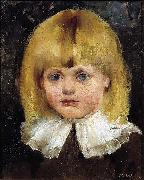|
||||||||||
|
|
||||||||||
|
Maria Wiik Måleriet identifieringen:: 78269 Titta min galleri i Sverige |
Maria Wiik Oil on canvass There were eleven daughters in the Tukianen family, at least three of which modelled for Maria Wiik. Hilja, who is 5 years old in this painting, also modelled for Helene Schjerfbeck. cyf Oil_on_canvass_There_were_eleven_daughters_in_the_Tukianen_family,_at_least_three_of_which_modelled_for_Maria_Wiik._Hilja,_who_is_5_years_old_in_this_painting,_also_modelled_for_Helene_Schjerfbeck. cyf |
|||||||||
|
|
||||||||||
|
1 | Föregående Konstnär Nästa Konstnär | |||||||||
|
|
||||||||||
| Maria Catharina Wiik | ||||||||||
| (b Helsinki, 2 Aug 1853; d Helsinki, 19 June 1928). Finnish painter. She studied in Paris at the Academie Julian from 1875 to 1876 under Tony Robert-Fleury and continued her studies with him in the same studio between 1877 and 1880. Her paintings appeared at the Salon for the first time in 1880 (e.g. Marietta, 1880; Helsinki, priv. col., see Katerma, p. 31). The realist techniques Wiik absorbed in Paris came to form the basis of her work, tranquil in composition and restrained in colour. Her favourite subjects were relatively small-scale portraits such as Hilda Wiik (1881; Helsinki, Athenaeum A. Mus.) and still-lifes (e.g. Still-life, c. 1880; Helsinki, Athenaeum A. Mus.). Like many other foreign painters Wiik went to Brittany to paint. In 1883-4 she worked in Concarneau and Pont-Aven, where her enthusiasm for plein-air painting brought immediacy to her work and greater brightness to her colours (e.g. Breton Farm, 1883; Naantali, Fereningen Hedvigsminne). She preferred to record her impressions in portraits, although she also painted small, light-filled landscapes. In 1889 Wiik worked under the direction of Puvis de Chavannes in Henri Bouvet's studio in Paris, and in the same year she visited St Ives where she painted, among others, two major works: Out in the World (Helsinki, Athenaeum A. Mus.) and the St Ives Girl (Helsinki, priv. col., see Katerma, p. 93). Both works show Wiik moving towards an ever more internalized and minimal mode of expression, thereby taking part in the process that led, in the 1890s, to a general abandonment of realism in favour of a greater emphasis on emotion. Out in the World, which shows an old woman's sad parting from a young girl who is leaving home to begin work, shows a change in technique with the use of more united colour surfaces and of tone painting. (This work was awarded a bronze medal at the Exposition Universelle in Paris in 1900.) During the 1890s and the early 20th century Wiik's travels were concentrated in Scandinavia, although she visited Paris in 1905. | ||||||||||
|
|
||||||||||
IntoFineArt Co,.Ltd.










